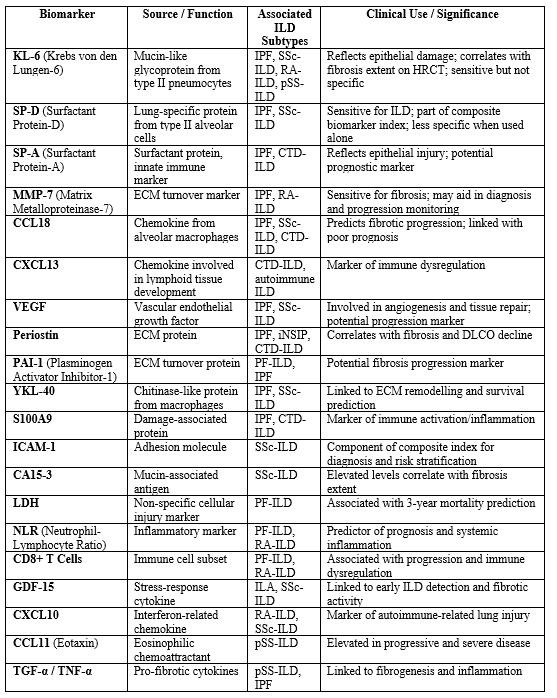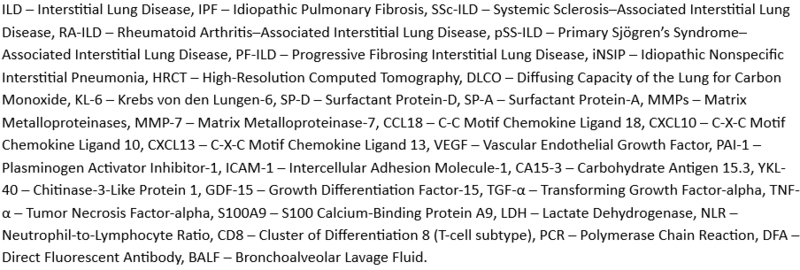Article: Biomarkers in Interstitial Lung Disease (ILD): What's New?
M3 India Newsdesk Jun 02, 2025
This article gives an overview of biomarkers used for earlier diagnosis, risk stratification, disease monitoring and tailoring therapy in Interstitial Lung Disease (ILD) management, along with the new developments in this evolving landscape.

Interstitial Lung Disease (ILD) encompasses a diverse group of more than 200 lung disorders characterised by varying degrees of inflammation and fibrosis. Despite this diversity, many ILDs share common clinical, radiologic, and pathological features, especially those that evolve into a chronic fibrosing phenotype.
In recent years, the pursuit of reliable biomarkers, measurable indicators of biological processes, has emerged as a central point in ILD research. A biomarker, also called a molecular marker and signature molecule, is a biological molecule found in blood, other body fluids, or tissues that is a sign of a normal or abnormal process, or a condition or disease.
Biomarkers hold promise for earlier diagnosis, risk stratification, disease monitoring, and tailoring therapy. Ideal biomarker should increase pathologically in the presence of the disease (high sensitivity), not increase in the absence of the disease (high specificity), add information about the risk or prognosis, change by the clinical evolution, reflecting the current status of disease, or better, anticipate relapse before it becomes obvious at a clinical level and finally relate to disease burden and be reproducible, easy and cheap,
Traditionally, ILD diagnosis and management are based on a combination of high-resolution CT imaging, pulmonary function tests (PFTs), 6-minute walk distance, and, at times, lung biopsies. However, these modalities can miss early disease or fail to predict progression. Biomarkers can help address these gaps, providing insights into disease activity, distinguishing subtypes, predicting prognosis, and even indicating therapeutic response.
KL-6 and Surfactant Proteins
Krebs von den Lungen-6 (KL-6) and surfactant proteins (SP-A and SP-D) remain among the most studied ILD biomarkers. New studies reaffirm KL-6 as a sensitive marker for epithelial injury and fibrosis, with strong diagnostic value in idiopathic pulmonary fibrosis (IPF), systemic sclerosis-ILD (SSc-ILD), and RA-ILD. Yet, KL-6 alone lacks specificity in autoimmune ILDs, where levels may remain normal despite active disease
Composite Indices
Recent work introduced a composite biomarker index combining SP-D, CA 15-3, and ICAM-1 to identify SSc-ILD. This index not only improved diagnostic performance but also correlated with disease severity and lung function decline. It may become a pivotal tool for early diagnosis, especially when imaging findings are equivocal.
Cytokine and Chemokine Panels
Cytokines such as IL-6, TNF-α, and chemokines like CCL18 and CXCL10 are emerging as markers of immune dysregulation and fibrotic potential. Elevated CCL18 levels, in particular, are associated with worse outcomes in both IPF and connective tissue disease-associated ILDs (CTD-ILDs), suggesting a role in risk stratification.
Genetic Markers: MUC5 B and Beyond
The MUC5B promoter polymorphism remains a robust genetic risk factor for IPF and RA-ILD, though not for SSc-ILD. Telomere-related genes like TERT and TERC also play a role in susceptibility and disease progression. While not yet standard in clinical care, such genetic insights are laying the groundwork for personalised medicine.
Emerging Biomarkers: Periostin, YKL-40, and GDF-15
Periostin and YKL-40 are involved in extracellular matrix remodelling and show promise in reflecting disease activity and fibrotic burden. GDF-15, elevated in early interstitial lung abnormalities, might allow preclinical ILD detection—a potential game-changer in rheumatology clinics. In the RECITAL trial, higher baseline levels of YKL-40 were independently associated with a lack of treatment response in CTD-ILD, highlighting its potential as a predictive biomarker, while CXCL-4, IP-10, and MCP-1 varied by disease subtype.
Higher Apolipoprotein A1 (ApoA1) levels in Idiopathic Pulmonary Fibrosis (IPF) are linked to better lung function and fewer respiratory hospitalisations, while Paraoxonase-1 (PON-1) shows no consistent benefit. A validated 12-biomarker panel developed by the Prognostic Lung Fibrosis Consortium (PROLIFIC)—including Surfactant Protein-D (SP-D), Krebs von den Lungen-6 (KL-6), Matrix Metalloproteinase-7 (MMP-7), and soluble Intercellular Adhesion Molecule-1 ( sICAM-1) correlates with forced vital capacity decline and transplant-free survival, supporting its use in IPF clinical trials.
Plasma Mast-Cell Expressed Membrane Protein-1 (MCEMP1) is a strong prognostic marker in IPF and other fibrotic Interstitial Lung Diseases (ILDs), predicting disease progression with high sensitivity and specificity. In Drug-Induced Lung Disease (DILD), serum syndecan-4 correlates with disease severity and lung function decline, suggesting prognostic value despite normal levels compared to healthy controls. In fibrotic ILD, low bioavailable testosterone in men and low Free Androgen Index (FAI) in women are associated with worse lung function and shorter Leukocyte Telomere Length (LTL), supporting further investigation into sex hormone supplementation.
Despite promising data, biomarker use in clinical practice is limited by variability in assay methods, disease overlap, and lack of long-term validation. Most studies have focused on IPF, highlighting the need for more robust research in autoimmune-related and hypersensitivity-related ILDs. Trials on biomarker-guided therapy escalation, especially in Progressive Fibrosing ILD (PF-ILD), are highly anticipated, ushering in a new era of personalised pulmonology.


Disclaimer- The views and opinions expressed in this article are those of the author and do not necessarily reflect the official policy or position of M3 India.
About the author of this article: Dr Priya Sharma is a Consultant Pulmonologist at Indraprastha Apollo Hospitals, Delhi.
-
Exclusive Write-ups & Webinars by KOLs
-
Daily Quiz by specialty
-
Paid Market Research Surveys
-
Case discussions, News & Journals' summaries